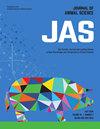Effect of multispecies fungal extract supplementation on growth performance, nutrient digestibility, ruminal fermentation, and the rumen microbiome composition of beef cattle fed forage-based diets
IF 2.7
2区 农林科学
Q1 AGRICULTURE, DAIRY & ANIMAL SCIENCE
引用次数: 0
Abstract
Our objective was to evaluate the effect of a multispecies fungal extract (MFE) on growth performance, apparent total tract digestibility (ATTD), fermentation characteristics, and rumen microbiome composition of beef cattle fed forage-based diets. For experiment 1, ruminally cannulated Angus × SimAngus cows (n = 4; body weight [BW] = 569 ± 21 kg) were used in a randomized crossover design with two 21-d study periods and a 23-d washout period to evaluate the effect of dietary inclusion of a MFE on in situ digestion, ruminal fermentation, and the composition of the rumen microbiome. Treatments consisted of a forage-based diet with or without the inclusion of a MFE. Rumen samples were collected on days 5, 10, and 20. Experiment 2 evaluated different inclusion rates of the MFE in a randomized complete block design using Angus × SimAngus-crossbred steers (n = 80; BW = 370 ± 44 kg). Steers were blocked by BW and randomly assigned to 1 of 4 treatments (2 pens/treatment): diet with no MFE, 0.02%, 0.04%, and 0.08% of the MFE (dry matter (DM) basis). Steers were fed a forage-based diet for 122 d. Subsets of 10 steers/treatment were randomly selected for the determination of ATTD on d 20, 40, and 60. All data were analyzed using the MIXED procedure of SAS. In exp 1, adding the MFE to the diet tended to increase the ruminal disappearance rate of the DM on d 10 (P = 0.06). No interactions or treatment effects were observed for the short-chain fatty acid profile of the rumen fluid (P ≥ 0.13). Metagenomic analysis of the rumen microbiome showed a MFE × d interaction for the Fibrobacter genus (P = 0.01), which on d 20 was less abundant in the rumen of cows fed the MFE. In exp 2, steers supplemented with 0.04% of MFE had a lower average daily gain and were lighter at the end of the experiment (cubic, P ≤ 0.04) compared to steers supplemented with 0.02% MFE. Steers fed the diet with 0.02% of MFE had the greatest gain to feed ratio among the MFE-supplemented groups (cubic, P < 0.01). Dietary inclusion of the MFE increased neutral detergent fiber digestibility (linear, P = 0.05). Steers supplemented with 0.04% of MFE had the greatest acid detergent fiber digestibility among treatments (quadratic, P = 0.03). Collectively, results showed that ruminal disappearance rate and digestibility of forage-based diets increased due to MFE supplementation, but did not translate into growth performance improvements or beneficially alter rumen fermentation.饲粮中添加多种真菌提取物对肉牛生长性能、营养物质消化率、瘤胃发酵及瘤胃微生物组组成的影响
本研究旨在评价多菌种真菌提取物(MFE)对饲喂草料型日粮肉牛生长性能、表观全道消化率(ATTD)、发酵特性和瘤胃微生物组组成的影响。试验1:瘤胃插管的安格斯×西芒格斯奶牛(n = 4;试验采用随机交叉设计,分为2个21 d研究期和23 d洗脱期,评估饲粮中添加MFE对瘤胃原位消化、瘤胃发酵和瘤胃微生物组组成的影响。治疗包括以饲料为基础的饮食,包括或不包括MFE。于第5、10、20天采集瘤胃标本。实验2采用随机完全区组设计,使用Angus × simangus杂交阉牛(n = 80;体重= 370±44公斤)。以体重为障碍,随机分配到4个处理(2栏/处理)中的1个处理:不添加MFE、0.02%、0.04%和0.08%的MFE(干物质(DM)基础)。饲喂以饲料为基础的饲粮122 d。在第20、40和60天,每组随机选择10头牛进行ATTD测定。所有数据采用SAS的MIXED程序进行分析。在试验1中,饲粮中添加MFE有提高第10天DM瘤胃消失率的趋势(P = 0.06)。瘤胃液短链脂肪酸谱未见相互作用或处理效应(P≥0.13)。瘤胃微生物组宏基因组分析显示,MFE与d之间存在交互作用(P = 0.01),在第20 d时,MFE在奶牛瘤胃中含量较低。在实验2中,与添加0.02% MFE的肉牛相比,添加0.04% MFE的肉牛平均日增重更低,试验结束时体重更轻(立方,P≤0.04)。饲粮中添加0.02% MFE组的料重比在MFE添加组中最高(立方、P &;lt;0.01)。饲粮中添加MFE可提高中性洗涤纤维的消化率(线性,P = 0.05)。饲粮中添加0.04% MFE的肉牛酸性洗涤纤维消化率最高(P = 0.03)。综上所述,饲粮中添加MFE提高了瘤胃消失率和消化率,但并未改善生长性能或改善瘤胃发酵。
本文章由计算机程序翻译,如有差异,请以英文原文为准。
求助全文
约1分钟内获得全文
求助全文
来源期刊

Journal of animal science
农林科学-奶制品与动物科学
CiteScore
4.80
自引率
12.10%
发文量
1589
审稿时长
3 months
期刊介绍:
The Journal of Animal Science (JAS) is the premier journal for animal science and serves as the leading source of new knowledge and perspective in this area. JAS publishes more than 500 fully reviewed research articles, invited reviews, technical notes, and letters to the editor each year.
Articles published in JAS encompass a broad range of research topics in animal production and fundamental aspects of genetics, nutrition, physiology, and preparation and utilization of animal products. Articles typically report research with beef cattle, companion animals, goats, horses, pigs, and sheep; however, studies involving other farm animals, aquatic and wildlife species, and laboratory animal species that address fundamental questions related to livestock and companion animal biology will be considered for publication.
 求助内容:
求助内容: 应助结果提醒方式:
应助结果提醒方式:


